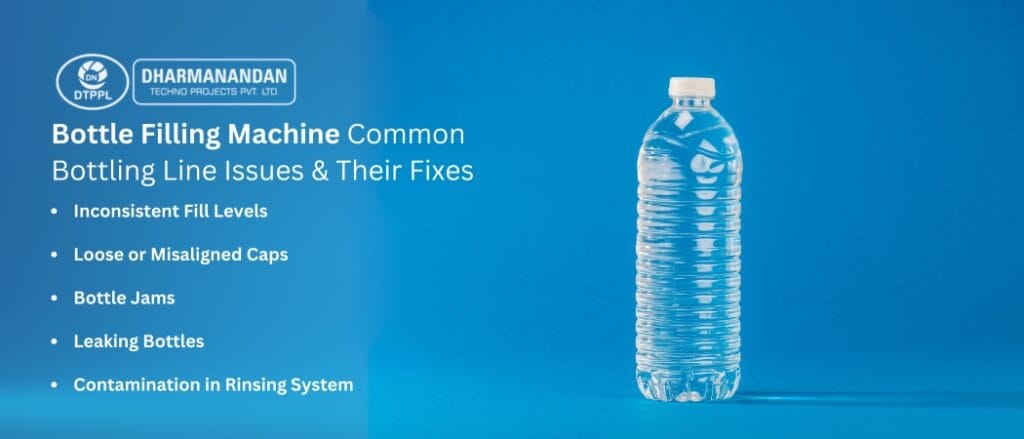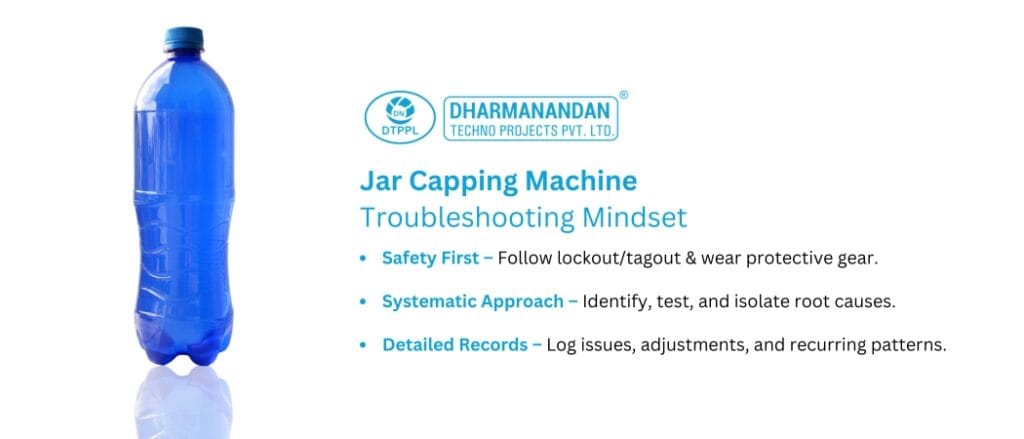
Table of Contents
Fully Automatic Bottle Rinsing, Filling, & Capping Machines Troubleshooting Guide
March 18, 2025
There’s nothing more frustrating than watching a fully automatic bottle rinsing, filling, and capping machine come to an unexpected halt. Everything was running smoothly—bottles rinsed, liquid filled precisely, and caps tightened just right—until suddenly, production stops. Bottles jam, fill levels become inconsistent, and caps refuse to sit correctly. The team scrambles to fix the issue while production losses continue to rise.
The bottling line is the core of any liquid packaging operation, but even the most advanced machines can experience disruptions. Troubleshooting is not just about fixing problems; it’s about diagnosing issues quickly, minimizing downtime, and maintaining seamless production.
This guide provides a practical, step-by-step approach to identifying, resolving, and preventing common bottling line failures. Whether dealing with inconsistent fills, cap misalignment, bottle jams, or leaks, this article serves as a reliable roadmap for maintaining peak performance.

Bottle Filling Machine Common Bottling Line Issues and Their Fixes
Before resolving a problem, it is important to identify its root cause. Below are the most frequent bottling line failures and effective troubleshooting methods.
1. Inconsistent Fill Levels
Uneven fill heights can lead to rejected batches, wasted product, and regulatory compliance issues.
Possible Causes:
- Faulty filling valves – Worn seals, sticking components, or improper adjustments affect liquid flow.
- Air trapped in product lines – Disrupts fluid movement, causing variations.
- Product viscosity changes – Temperature fluctuations can alter liquid thickness.
- Foaming issues – Excessive foam can interfere with accurate filling.
- Level sensor malfunctions – Faulty sensors can misread fill levels.
- Bottle misalignment – Incorrect positioning under filling nozzles leads to uneven fills.
Troubleshooting Steps:
- Observe the filling process to identify signs of dripping valves, foaming, or erratic filling patterns.
- Disassemble, clean, and inspect filling valves for worn-out parts.
- Bleed air from product lines by opening bleed valves to release trapped air.
- Control product temperature to maintain consistent viscosity.
- Test and recalibrate level sensors.
- Adjust filling speed to reduce foaming.
2. Loose or Misaligned Caps
Loose caps cause leaks, while overtightened caps can damage bottle necks.
Possible Causes:
- Incorrect capping torque – Either too high or too low.
- Worn capping chucks or jaws – Loss of grip affects cap application.
- Misaligned cap feeder – Caps arrive at the capping heads in the wrong position.
- Bottle misalignment – Incorrect positioning under capping heads prevents proper sealing.
Troubleshooting Steps:
- Use a torque tester to measure and adjust capping torque settings.
- Inspect capping chucks or jaws for signs of wear or damage.
- Observe the cap feeder to ensure caps are fed smoothly.
- Check bottle alignment under capping heads to prevent angled caps.
3. Bottle Jams
A single bottle jam can bring an entire production line to a stop.
Possible Causes:
- Deformed or damaged bottles – Weak bottles are more prone to jamming.
- Star wheel misalignment – Improper rotation prevents smooth bottle movement.
- Conveyor issues – Worn belts or misaligned guides cause spacing errors.
- Timing problems – Poor synchronization leads to bottle collisions.
Troubleshooting Steps:
- Power off and lockout the machine before attempting to clear a jam.
- Identify and remove jammed bottles carefully.
- Inspect bottle quality for dents, cracks, or weak plastic.
- Check conveyor belts and adjust guide rails.
- Ensure the star wheel timing is aligned correctly.
4. Leaking Bottles
Leaks compromise product integrity and can lead to contamination.
Possible Causes:
- Loose caps – Insufficient torque leads to improper sealing.
- Damaged cap seals – Missing or broken liners cause leaks.
- Faulty bottle neck finishes – Chips or cracks prevent a secure seal.
- Product residue on bottle threads – Dripping liquid from filling nozzles interferes with capping.
Troubleshooting Steps:
- Test and recalibrate capping torque settings.
- Inspect cap seals and bottle necks for defects.
- Check for filling valve drips that could be affecting sealing.
5. Contamination in the Rinsing System
If bottles are not properly rinsed, contamination can ruin entire batches.
Possible Causes:
- Poor water filtration – Impurities remain in the rinse water.
- Bacterial growth – Stagnant water fosters bacteria.
- Improper cleaning cycles – Inadequate sanitation leads to contamination.
Troubleshooting Steps:
- Test the quality of the water used in the bottle rinsing machine to detect contaminants.
- Replace clogged filters in the rinsing system.
- Verify that sanitation cycles are properly followed.

Bottle Rinsing Machine Advanced Troubleshooting: Predictive Maintenance for Bottling Lines
While traditional troubleshooting fixes problems after they occur, predictive maintenance identifies early warning signs to prevent failures.
Key Predictive Techniques:
- Data logging and analysis – Track fill levels, capping torque, and system pressure over time.
- Sensor monitoring – Use IoT-enabled sensors to detect inconsistencies.
- Statistical process control (SPC) – Identify patterns before they become failures.
- Machine learning algorithms – Predict breakdowns based on historical data.
The Mindset of a Bottle Capping Machine Troubleshooter
1. Safety First
Always follow lockout/tagout procedures before working on the machine. Use proper protective gear to avoid injuries.
2. Be Systematic
- Define the problem – Avoid vague descriptions like “machine acting up.”
- Gather information – Identify symptoms, operating conditions, and recent changes.
- Test hypotheses – Start with the simplest solution before moving to complex ones.
- Isolate the root cause – Eliminate possible issues one by one.
3. Keep Detailed Records
- Log every troubleshooting step, observation, and corrective action.
- Maintain records of fill level inconsistencies, torque adjustments, and sensor calibrations.
- Use troubleshooting logs to identify recurring patterns.
4. Consult the Manufacturer’s Manual
Each machine has unique settings and maintenance procedures. Always refer to manufacturer guidelines before making adjustments.


Conclusion: Ensuring Bottling Line Efficiency
Troubleshooting fully automatic bottle rinsing, filling, and capping machines requires technical expertise, logical problem-solving, and preventative strategies. Addressing issues systematically leads to reduced downtime, better efficiency, and consistent product quality.
DTPPL is a trusted fully automatic bottle rinsing, filling, capping machine, and mineral water plant manufacturer and supplier. If you’re looking for reliable, high-performance solutions for your bottling operations, contact us today to optimize your production efficiency.

Director – Global Marketing and Sales
Mr. Bhavesh from Dharmanandan Techno Projects Pvt. Ltd. has played a pivotal role in elevating the DTPPL brand to the global stage, leveraging his exceptional expertise in marketing and communications. He is committed to helping clients achieve significant growth while strengthening their own brands. Dharmanandan Techno Projects Pvt. Ltd. is a leading manufacturer and supplier of water purification systems and turnkey solutions for mineral water plants. With years of experience in designing and delivering high-quality water treatment solutions, the company provides end-to-end services, including system design, installation, maintenance, and ongoing support. Specializing in scalable and customizable water plants, DTPPL has successfully served industries worldwide, ensuring clean and safe drinking water across diverse applications.
